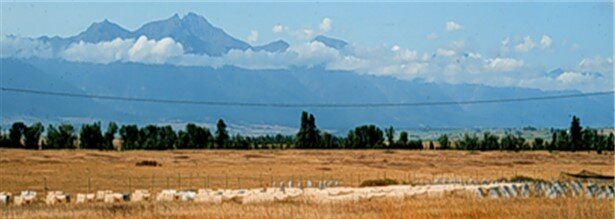Over 40 years of monitoring, an endangered bunchgrass prairie became hotter, drier and more susceptible to fire annually—but dramatic seasonal changes (not annual climate trends) seem to be driving the biggest changes in plant production, composition, and summer senescence. Gary Belovsky and Jennifer Slade of The University of Notre Dame, Indiana, present these findings in the open-access journal PLOS ONE on December 23.
Intermountain bunchgrass prairie is one of North America’s most endangered ecosystems, now covering less than 1 percent of the area it once did. Over the past century, bunchgrass prairies have become warmer and drier, and human-driven climate change is expected to continue that trend, with potential impacts on bunchgrass ecosystems. However, bunchgrass is often overlooked in studies of grasslands.
To better understand the effects of climate change on bunchgrass prairies, Belovsky and Slade studied the National Bison Range, a bunchgrass prairie in Montana, for 40 years. They made repeated observations of plant growth and production, abundances of different plant species, and availability of nitrogen (an important nutrient for plants), generating a comprehensive timeline of ecosystem changes.
Over the course of the study, annual temperatures rose and precipitation declined in the prairie, making it more susceptible to fire. Surprisingly, the researchers found that annual aboveground primary production—the amount of plant material produced every year—rose by 110 percent, associated with increased precipitation and cooler temperatures during the important growth period of late May through June. However, this was associated with a change in plant composition, with a 108 percent increase in invasive species, more drought-tolerant species being favored overall, and declines in dicot non-grass plants (decreasing by 65 percent) over the 40-year study period.
The researchers also found that other ecosystem changes followed seasonal climate trends, instead of annual trends. For instance, summer temperatures were higher than might be expected from annual trends, boosting summer senescence— the yearly “browning” of green plant material.
These findings highlight the importance of considering local and seasonal changes when forecasting the effects of climate change on a given ecosystem. The authors report that intermountain bunchgrass prairie could be morphing into a different type of grassland that may be previously unknown.
Dr. Belovsky adds: “Forecasting climate change effects on plant production based on expected average annual increased temperature and decreased precipitation may not be appropriate, because seasonal climate changes may be more important and may not follow average annual expectations.”
Elevated carbon dioxide suppresses dominant plant species in a mixed-grass prairie
More information:
Belovsky GE, Slade JB (2020) Climate change and primary production: Forty years in a bunchgrass prairie. PLoS ONE 15(12): e0243496. doi.org/10.1371/journal.pone.0243496
Provided by
Public Library of Science
Citation:
Capturing 40 years of climate change for an endangered Montana prairie (2020, December 23)
retrieved 23 December 2020
from https://phys.org/news/2020-12-capturing-years-climate-endangered-montana.html
This document is subject to copyright. Apart from any fair dealing for the purpose of private study or research, no
part may be reproduced without the written permission. The content is provided for information purposes only.



